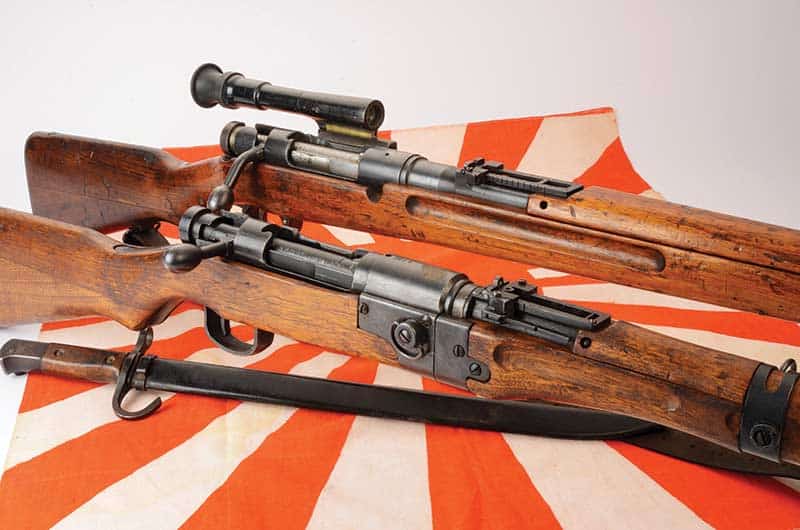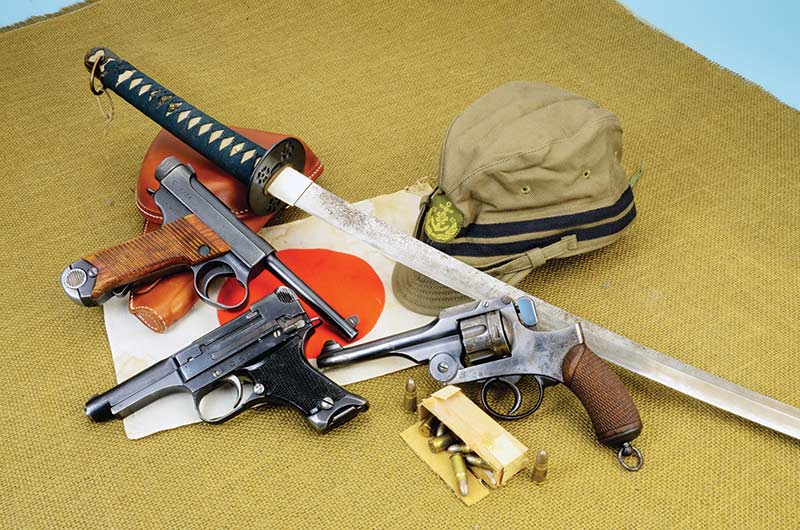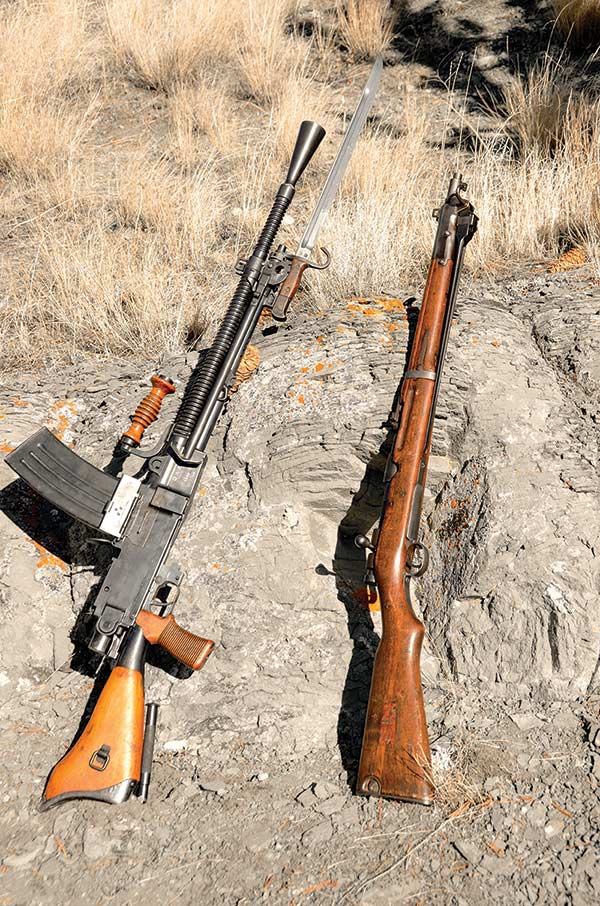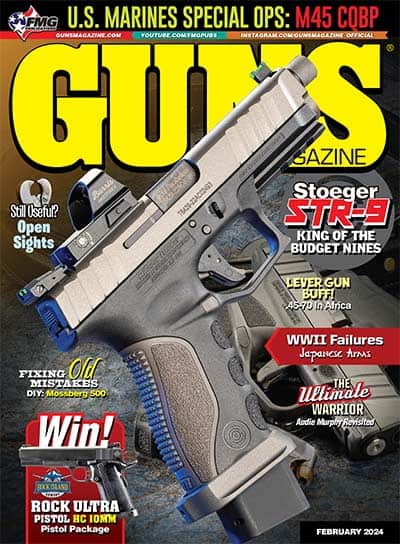Japanese WWII Weapons’ Faults
Good Quality But Poorly Designed
Japanese weapons of World War II are generally denigrated as low-quality junk but until late in the war, this charge was far from the truth. Japanese rifles, carbines, light machine guns and even handguns were built with high craftsmanship, especially in regard to metal work. I know this because I own samples of most of those firearms. The problem was Japanese military firearms were not well-thought-out — a logical outcome because, as a nation, Japan had a rather short firearms history.
Catalog Of Handgun Failure
Let’s look at some of these deficiencies. The Type 26 revolver was chambered for a specific 9mm rimmed cartridge with a six-round capacity and was double-action only. That’s no big deal. However, the cylinder locks in place only as the trigger is pulled. When it’s released, the cylinder “free wheels,” meaning it can rotate so the next round up could possibly be a previously fired one. Also, the revolver’s lockplate is hinged and easily opened to reveal the lockwork. This is good for cleaning but makes it easy for curious or untrained fingers to tinker about. By World War II, Type 26 revolvers were relegated to NCOs so perhaps they were not inclined to be as inquisitive about their revolver’s mode of functioning.
Next up are the Type 14 and Type 94 semi-auto pistols. First off, they were chambered for the weak 8mm Nambu cartridge, named after Col. Nambu who designed both pistols. Hardly has there even been a more dangerous handgun issued to a military force. There is a sear bar exposed along the pistol’s left side. If a Type 94 is cocked with a round chambered, even lightly touching the bar will fire it.
The Type 14 was a much better design. Its receiver is a tube with the bolt sliding within. Bill Ruger actually borrowed the idea for his .22 LR Mark I pistols. However, when the Type 14 has fired the last round in its magazine, there is no bolt hold-open device. The magazine follower itself serves the purpose, making the magazine difficult to pull free from the grip and allowing the bolt to slam closed when removed. The pistol must be cycled again when a fresh magazine is inserted. Lastly, Type 14s were issued with a spare firing pin, which could not have inspired confidence about them
Rifles
Japanese rifles and carbines are basically good because they are all based on Peter-Paul Mauser’s Model 1898 actions. They were adapted to Japanese use by a Col. Arisaka whose name is synonymous with virtually all their rifles and carbines of World War II. As such, they were all five-shot, bolt-action models with magazines contained inside the wooden stock.
The Japanese just could not leave well enough alone. For instance, instead of a lever at the rear of the rifle’s bolt for safety, they put a mushroom-shaped knob at the bolt’s rear. It was meant to be turned with the palm of the shooter’s hand instead of his fingers.
Another unnecessary feature was the rifles and carbines were issued with receiver covers that moved back and forth with the bolt. No other military rifle of any nation in World War II was deemed to need its action protected. Besides, the covers rattled. Japanese Army and Naval Landing Forces troops must have discarded those covers by the ton. Few of the many thousands of rifles and carbines floating around the United States still have them.
Sight For Sore Eyes
Then we get to the sights. Most nations put “wings” on either side of their rifles/carbines front sights to protect them, especially when bayonet fighting. With most military rifles, these “wings” flared away from the sight itself. Instead, the Japanese had them standing straight. When rushed, it is easy to see one of those straight “wings” in the rear sight causing the shooter to fire off laterally to one side or another. I found this out when doing run and shoot courses in Thunder Ranch’s old Rifle Classes.
Speaking of “wings” — with their Type 99 Arisaka 7.7mm rifles, the Japanese put folding “wings” on their rear barrel-mounted peep sights. They were there to provide lead when riflemen were aiming at low flying aircraft. Shooting at 300 mph airplanes with bolt-action rifles? Those folding wings were just something else to catch on brush in jungle fighting.
As to the peep sight, such sights are well regarded in some quarters. With Britain and the U.S., most of their World War II rifles and carbines carried peep sights set at the rear of their receivers. Instead, the Japanese put their peep sights way out on the rifle barrel. Mounted close to the eye, peep sights are fast to use. Mounted out on a barrel, the shooter’s eye must search for them. Again, I learned this at Thunder Ranch.

At rear is a Type 97 6.5mm sniper rifle (above). Note its offset scope.
At front is a Type 99 take-down 7.7mm rifle intended for paratroopers
with barrel-mounted peep sights. Shown below are three handguns the
Japanese used in War II. From left, the Type 14, 8mm Nambu; Type 94,
8mm Nambu; and Type 26, 9mm Rimmed.
Sniper Rifles
The Japanese fielded two versions of sniper rifles — Type 97 6.5mm and Type 99 7.7mm. Except for a small number of adjustable telescopic sights on Type 99s late in the war, Japanese sniper scopes had no means of adjustment. They were mounted at the armory, roughly zeroed by ordnance officers and then handed out to troops. The scopes’ reticles had various lines and “tic” marks for windage and elevation. It was the troops’ duty to figure out which marks to use for various ranges and wind conditions.
The scopes were also mounted offset to the rifle’s actions, which introduced another variable. By much experimentation I’ve been able to get first shot hits at 100 and 200 yards with my Type 97 6.5mm but at 300 yards, it’s about a 50/50 chance of hitting with the first shot.
Last is the Japanese fixation on bayonets. Their Type 99 7.7mm LMG weighs 20 lbs. and was issued with a bayonet. Hoisting about a bayoneted 20-lb. LMG in combat seems a sure way to get hurt. Over the past 20 years, I’ve shot thousands of factory rounds and handloads through my Japanese World War II firearms collection.





